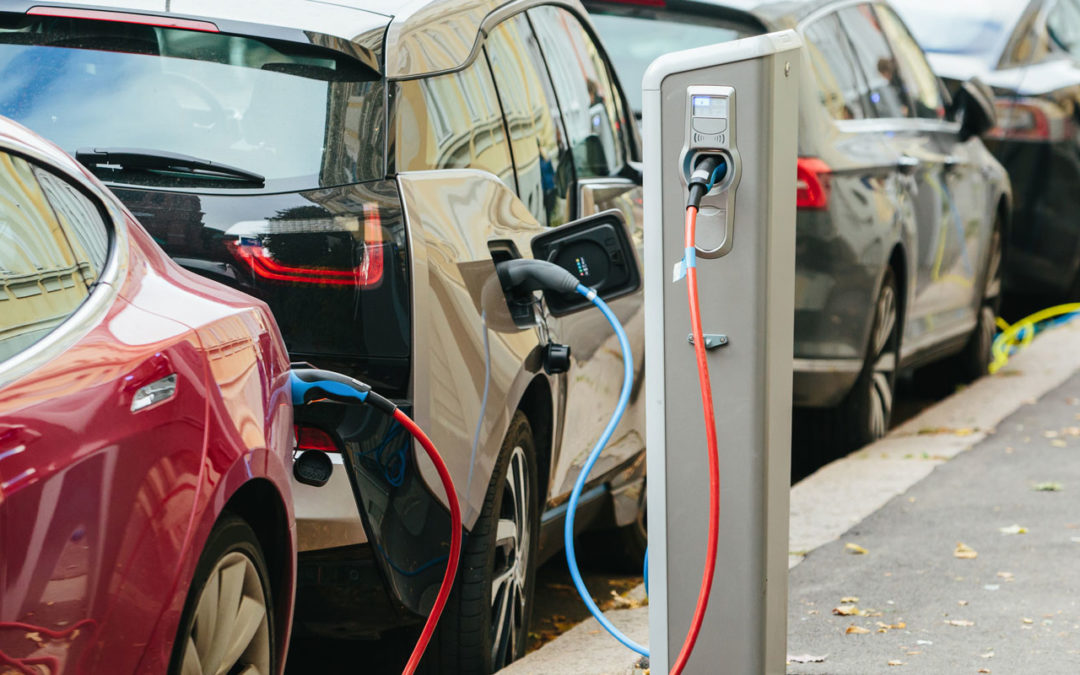
by Jane McCurry | May 31, 2019 | Electric Vehicles
On May 28th the Assembly Energy and Utilities Committee held a hearing on Assembly Bill 233. The bill would allocate a little over $10 million of the Volkswagen Settlement money to fund electric vehicle charging stations in Wisconsin.
RENEW Wisconsin, Customers First! and Wisconsin Conservative Energy Forum all spoke in favor of the goal of the bill. We stressed the importance of preparing Wisconsin for the coming transition to electric vehicles, and, with our allies, made the case for using Volkswagen Settlement Funding to do so. A number of other groups testified with concerns about specific provisions that they believe need to be changed.
Representative Adam Neylon (R-Pewaukee) and Senator Robert Cowles (R-Green Bay) are the lead authors of the bill. They both agreed that the legislation needs some work but they are committed to adjusting the proposal to ensure it best serves the mission of the bill, which is to increase access to electric vehicle charging in Wisconsin.
This legislation is similar to a proposal that Governor Tony Evers put into his budget bill. RENEW is working with stakeholders and elected officials to address the details of the bill and bolster support for using $10 million of the VW Funding for electric vehicle infrastructure.
In our testimony below, we highlighted the benefits of electric vehicles, the need for fast-charging stations, and our concerns with AB 233 that we feel need to be fixed for this legislation to be passed or for it to be included in the budget bill.
There is still time to get involved! Please reach out to your legislators to support AB 233 and Governor Evers budget proposal.
For more information on the background of the Volkswagen Settlement, see previous Electric Vehicle Blogs: Volkswagen Settlement Update and “The Volkswagen Settlement” – A Big Opportunity for Electric Vehicles.
Assembly Bill 233 – Clean Energy Corridor Grants
Testimony before the Assembly Energy and Utilities Committee
Tuesday, May 28, 2019
Jim Boullion, Director of Government Affairs
Jane McCurry, Electric Vehicles Program Manager
Jim Boullion: Chairman Kuglitsch and committee members, thank you for the opportunity to speak to you today. My name is Jim Boullion, Director of Government Affairs for RENEW Wisconsin. With me, and also from RENEW Wisconsin, is Electric Vehicles Program Manager Jane McCurry.
RENEW Wisconsin is a nonprofit organization founded in 1991 that promotes all forms of renewable energy in Wisconsin. We work on policies and programs that support solar, wind, biogas, geothermal energy and electric vehicles.
RENEW Wisconsin supports AB 233 and its goal of expanding the availability of electric vehicle charging stations in Wisconsin.
I would like to turn it over to Jane McCurry to share information with you about the market for electric vehicles, details of the Volkswagen Settlement and why this legislation is needed.
Jane McCurry: The market for electric vehicles is changing fast. The upfront price of an electric car is dropping, and is expected to reach parity with internal combustion engine cars by the mid-2020s. Every major auto manufacturer has pledged to overhaul their vehicle offerings. We expect almost 200 new electric vehicle models to be available in the next few years, from SUVs to pickup trucks and sedans.
While most electric vehicle charging is done at home, public charging stations are needed for citizens who live in multifamily buildings, who travel long distances for work, and to support our robust tourism sector. Currently, Wisconsin only has 32 fast charging locations, most of which are densely located in the Madison and Milwaukee areas. In order to make driving electric accessible for everyone in Wisconsin, we need to build a network of fast rechargers that will allow both urban and rural Wisconsinites to drive electric with confidence.
The Federal Volkswagen Settlement, where the money for this bill originates, specifies that the funding can only be used for certain purposes. The Settlement authorizes using up to 15% of the funds for zero emission vehicle infrastructure. As of today, 45 states have opted to use part or all of their available zero emission vehicle infrastructure funding to build out the electric vehicle infrastructure in their state. Wisconsin is one of only 4 states that has submitted a plan for using Volkswagen Funds that did not take advantage of this opportunity.
In the Midwest, there is consensus that we need to act now. Illinois, Indiana, Iowa, Michigan, Minnesota, and Ohio are all using the available Volkswagen funding for charging station infrastructure. Each of our Midwest neighbors have slightly different programs for utilizing the funding, however, the consensus very much reflects AB 233’s plan to prioritize fast charging along major highway corridors.
Because 85% of Wisconsin’s Volkswagen funds must be used for retrofitting or replacing diesel vehicles, we strongly support using the remaining 15% to create a permanent network of high-speed public charging stations, which would give people and businesses the confidence they need to buy hundreds of thousands of electric vehicles in the coming years.
We believe that investing this 15% of the funds in charging stations is by far the best use Wisconsin’s Volkswagen Settlement funding. It is a long-term investment in a critical technology that will last for decades and will benefit everyone in our State.
I will now turn it back over to Jim to make our comments on the specifics of AB 233.
Jim Boullion: The coming increase in electric vehicles on the road is such an important issue that the Wisconsin Public Service Commission recently started an informational docket on the subject. The information collected in that docket may provide valuable information to the Legislature in finding workable solutions to some of the issues identified in this bill.
As to a few of the individual items in the bill, we have the following comments:
- 20% to the transportation fund: RENEW does not object to EVs and EV charging stations paying their fair share to support road construction. However, including a provision on road funding in this particular grant program presents some problems:
- This would create a tax on charging stations that receive grant money but not on other charging stations. This will be anti-competitive and difficult to implement.
- Instead of establishing a 20% tax, we would recommend including in the legislation a directive to the PSC asking them to make a recommendation on the best method for public vehicle charging stations to contribute to the road fund.
- Time of use fees: As currently written, Grant recipients may only charge a parking fee based on the length of time at the charger and not on the amount of electricity consumed.
- For a level 2 charger this is not an issue because the flow of energy can be almost equally received by all models of electric vehicles. On a DC fast charger, however, a Chevrolet Bolt can accept only 50 kW of power, but a Tesla Model 3 can accept 125 kW. So, if both cars were plugged in for the same period of time, the Model 3’s battery would be filled with 2 and a half times more electricity.
- The inequity of getting less power for the same amount of money on a per minute system is a problem. To address it, at least 21 states have allowed financially charging by the electron specifically for electric vehicle charging stations without violating public utility laws.
- This is an issue that the PSC has included in their EV docket and they will likely make a recommendation on how this should be handled.
- Grants may not exceed 50% of the cost to purchase and install a charging facility:
- We agree that grantees need to have “skin in the game,” but the 50% limit may reduce the number of DC fast charging stations that will be deployed using these funds. For example, Pennsylvania allocated $1 million in funding, not part of the Volkswagen Settlement, for 50% matching grants. Their fund did not get any applications until they increased the percentage. Especially in more rural areas of Wisconsin, we may need more than 50% of matching funds to incentivize the installation of fast chargers.
- We would recommend limiting the grants for level 2 chargers to 50% and allowing grants for DC Fast Chargers up to 75%. Allow the PSC to determine through their application criteria what proposals best serve the State’s goals.
Wisconsin’s plan to use $10,065,000, the full 15% of our allotted settlement funding, will go a long way toward ensuring Wisconsin will not fall behind in the transition to electric transportation. These charging stations will kickstart a whole new market of transportation that will benefit our State and local economies for decades to come. This is an opportunity to ensure all Wisconsin citizens have access to electric vehicles.
Not only that, but electric vehicles provide an opportunity to fuel our transportation with clean, homegrown energy that is produced right here in Wisconsin. Wisconsin spends $8.2 billion each year on fuel for transportation that comes from out-of-state. The program created by AB 233 will bolster our local energy production and local economies for decades to come.
Thank you for the opportunity to speak to you today. We are very excited to see your leadership investing in the transition to clean, high-tech transportation.

by Jim Boullion | May 23, 2019 | Advocacy, Electric Vehicles
LEGISLATIVE ALERT!
Contact your Legislators to Support Public Electric Vehicle Charging Station Funding!
AB 233 was introduced on May 22nd and has already been scheduled for a public hearing this Tuesday, May 28. The bill designates a little over $10 million of the Volkswagen Environmental Mitigation Trust money to provide matching grants for the installation of public electric vehicle charging stations in Wisconsin. Governor Tony Evers included a similar proposal in his 2019 Budget Bill. While the two proposals have some differences that need to be worked out, everyone agrees that we need to continue building our electric vehicle charging infrastructure to support the transition to electric vehicles that is coming to Wisconsin! We need your help to get this bipartisan proposal passed into law!
Email your legislators or attend the public hearing to support AB 233!
PUBLIC HEARING
Assembly Bill 233
Relating to: charging facility grant program and making an appropriation.
By Representatives Neylon, Kuglitsch, Allen, Kitchens, Kulp, Mursau, Petryk, Skowronski, Spiros and Tauchen; cosponsored by Senator Cowles.
AB 233 Provisions
- Use $10 million of the Wisconsin portion of the Volkswagen Emission Settlement funds to provide grants to install electric vehicle charging facilities.
- “Charging facility” includes level 2 and fast charging equipment and analogous successor technologies that are available to the general public.
- The PSC will designate a clean energy corridor consisting of contiguous state trunk highways connecting Wisconsin to Minnesota, Michigan, Iowa, and Illinois.
- The PSC will develop grant criteria to determine eligible applicants for the grants at places of business located along the clean energy corridor.
- Grant recipients may charge a parking fee to use the facility if the fee is based on the time length of a session of use and not on the amount of electricity consumed by the user during a session of use.
- Grants may not exceed 50% of the cost to purchase and install a charging facility.
- The PSC may award multiple grants to a single applicant.
- Utilities that receive revenue collected from the charging facilities shall remit to the PSC 20% of that revenue, who will then deposit it into the state transportation fund.
Thank you for your support!
If you have any questions or would like more information please contact Jim Boullion, RENEW Wisconsin’s Director of Government Affairs at jim@renewwisconsin.org, or call at (608) 695-7004.
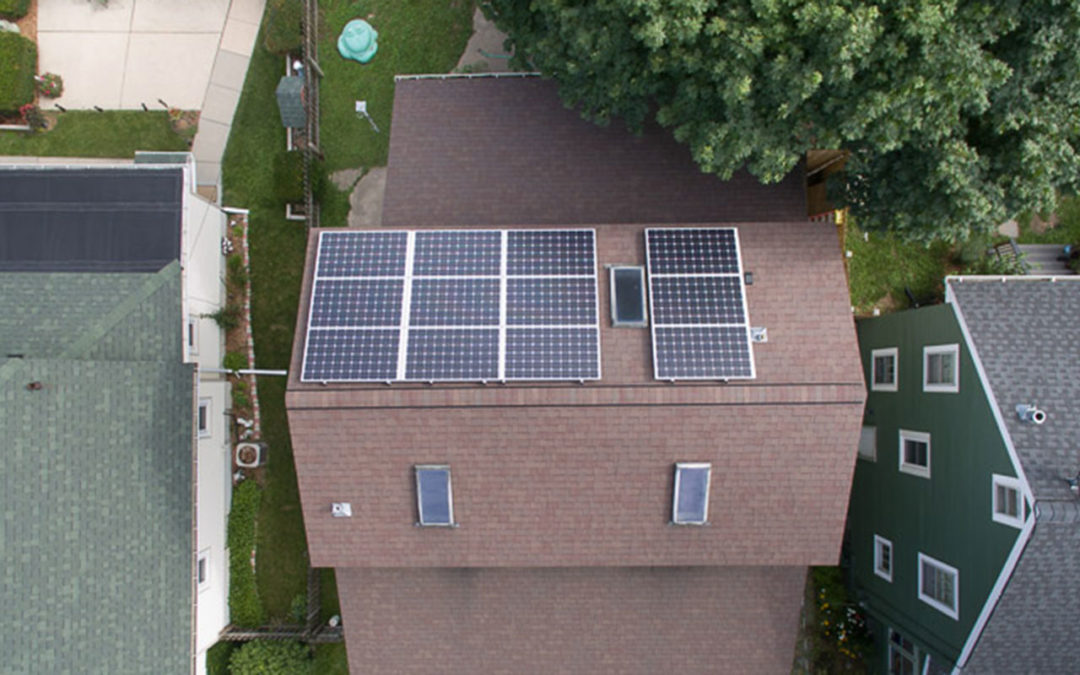
by Tyler Huebner | May 23, 2019 | Advocacy, Public Service Commission, RENEW Wisconsin, Renewables, Solar, Utilities
On May 3rd, We Energies filed an unfortunate proposal that would effectively tax their customers who make power for their own use with solar panels or other renewable energy systems.
We Energies’ proposal, filed as part of their rate case at the Public Service Commission, revives a nearly-identical approach which was rejected by a Circuit Court Judge in 2015.
This time around, they’ve named their tax the “Fixed Cost Recovery Charge.” It would assess a charge of $3.53 per kilowatt of solar production, or about $180 per year for the average residential solar installation by We Energies’ estimation. This would mean a reduction of 20-25% of the expected dollar savings from a typical solar installation.
The charge would be $3.67 per kilowatt for small commercial customers, and We Energies stated they are planning to propose a similar charge for larger commercial and industrial customers which has not yet been formally filed.
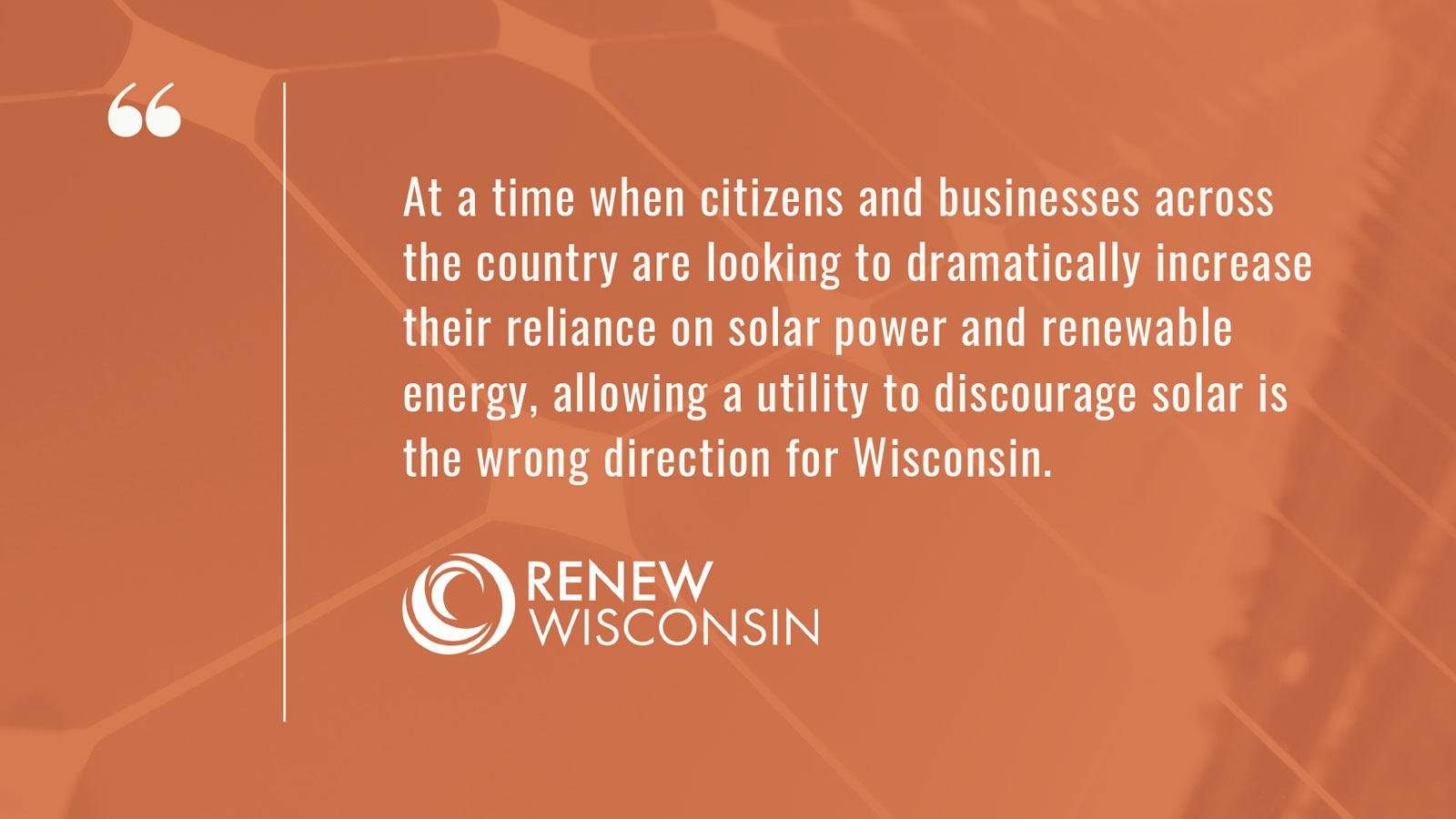
This Proposal is Out of Step and Bad for Wisconsin
Just last month, very similar charges were rejected by the Michigan Public Service Commission and failed to pass in the Iowa House of Representatives. The Michigan PSC said the proposed charge was not based on the cost of serving customers and was thus unreasonable. In Iowa, a wide coalition, including the Iowa Pork Producers, opposed the “sunshine tax” and it failed to pass before the Legislature adjourned for the year.
At a time when citizens and businesses across the country are looking to dramatically increase their reliance on solar power and renewable energy, allowing a utility to discourage solar is the wrong direction for Wisconsin.
Let’s Support Investments in Solar and Renewable Energy, Not Penalize Them
There are so many reasons to support solar power and oppose this solar tax!
- Solar is a growing industry in Wisconsin. The industry already employs over 3,000 Wisconsinites, and it’s just getting started.
- Homegrown energy keeps our money in Wisconsin. According to the U.S. Energy Administration, Wisconsin ratepayers spent $700 million on natural gas and $893 million on coal to generate electricity in 2017. This is money sent out of state, since we have no coal or natural gas reserves. We should be encouraging private investments in homegrown energy generation like solar that keep our money in Wisconsin.
- Clean energy brings economic development. Leading businesses across Wisconsin and the country increasingly want access to renewable energy. It’s going to be harder to attract these job creating businesses if our utilities are allowed to discourage them from investing in renewable energy solutions.
- We should encourage private sector investment. Individuals and businesses putting their own money into solar power and renewable energy systems is a good thing, and should not be penalized or discouraged.
- Solar helps keep energy costs down. With solar power, customers are providing peak power on those hot sunny days when we need it most. Every dollar invested by a person or business to generate their own energy lowers the demand on the entire system, and reduces the need for everyone to pay for more power plants and transmission lines to meet higher peak energy demands.
- ALL solar is good. We Energies itself is starting to offer solar power programs for some of its larger customers, and telling investors they plan to reshape their power generation to include more solar. We completely agree that We Energies should be maximizing the benefit of solar. But they can’t discourage solar while simultaneously talking about how great it is. “What’s good for the goose is good for the gander.”
- Solar helps families and businesses cut costs and manage expenses. Solar power has become an affordable way to save money for many families and businesses. We need to make sure farmers, residents, businesses, and even our local governments have the opportunity to take advantage of the cost savings from solar and renewable energy.
- Solar promotes cleaner air and water, now and into the future. Right now, Wisconsin is still using coal for 50% of our power! We all know that leads to air pollution and that coal emits carbon dioxide. Solar power systems located on homes and businesses, and owned by Wisconsin citizens and businesses, can help clean up our air and water now and for generations to come.
More information can be found at wisolarcoalition.com. The Wisconsin Solar Coalition is a growing alliance of nonprofits, businesses, and individuals.
Please join us by taking action today! Sign our petition opposing We Energies’ proposal to tax solar panel owners.

by William Dean | May 20, 2019 | Solar
Over the past few weeks we have seen some exciting approvals of major solar farms in Wisconsin. The Badger Hollow, Two Creeks, and Richland County solar projects would combine to be 500 megawatts (MW) of solar power capacity, enough to supply about 130,000 homes’ average electricity usage each year in Wisconsin. Once completed, the 500 MW of solar photovoltaic (PV) will increase the state’s solar capacity five-fold. But a concern has been raised about how much land these projects will use, and the implications of future solar farms on Wisconsin cropland.
To learn more about these issues, we have analyzed the intersections of utility-scale solar PV and conventional agriculture and found a number of interesting points centered on the change in crop production and harvested land in Wisconsin.
Crop Production in Wisconsin • 1982-2017
Our first analysis looks at the change in total harvested cropland from 1982 to 2017 and links this to the change in the amount of crops actually produced over the same time period. The key finding here is simple: we are growing more crops today than we were 35 years ago and doing so on fewer harvested acres of land.
Taking data from USDA National Agricultural Statistics Service, we analyzed conventional harvested crop groups in Wisconsin between 1982 to 2017. We had some important findings. One, the total amount of land harvested for all crops has decreased by about 9% from 1982 to 2017. In 1982, a little more than 10 million acres of land was harvested exclusively for the production of crops. In 2017, total harvested cropland totaled 9.2 million acres. Figure 1 below shows the change in total harvested land in these 35 years. In short, urban and suburban development, federal farmland preservation programs, improved crop yields, and farm retirements and closures have contributed to this loss of harvested crop land.
Figure 1.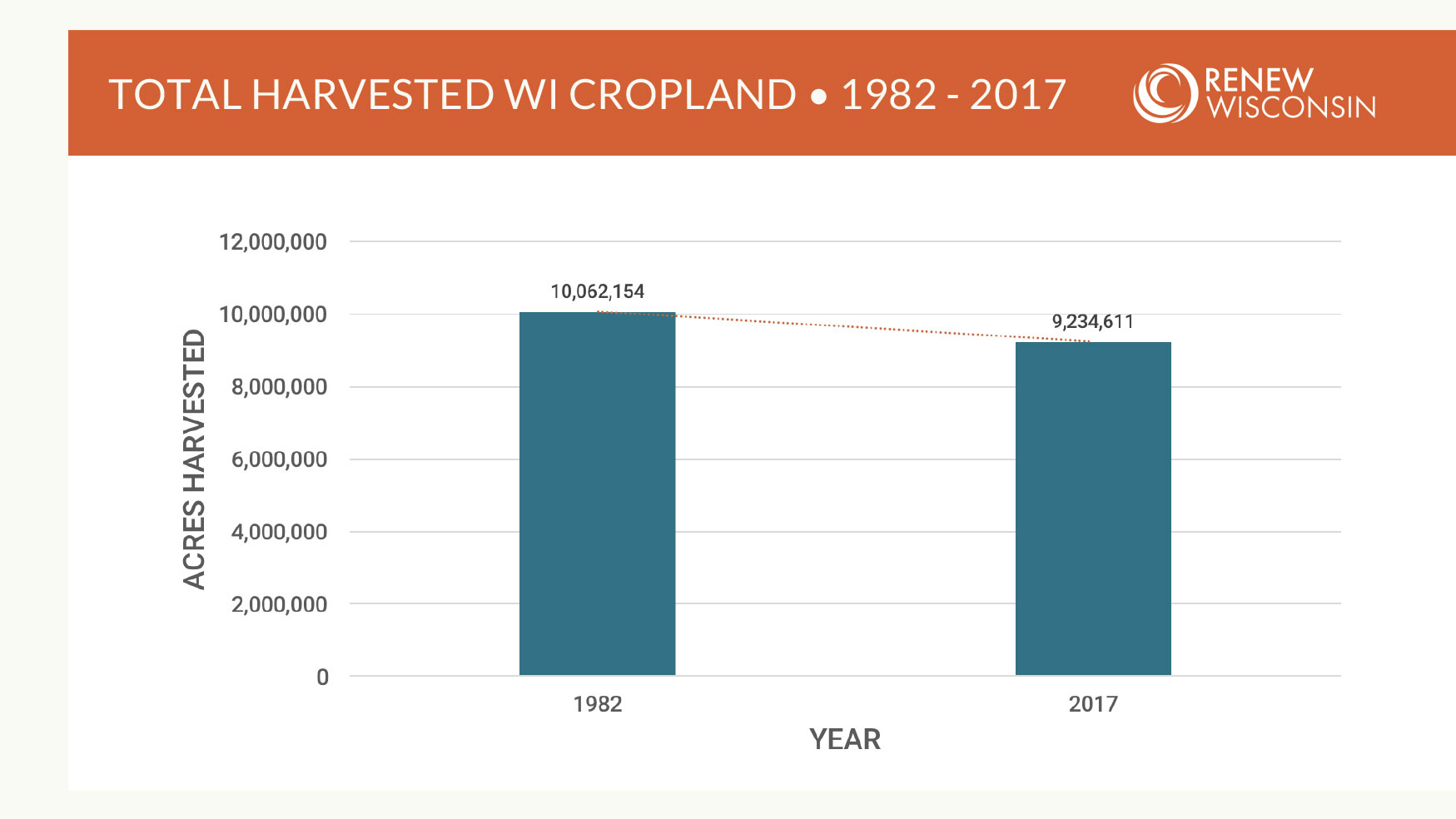
The Ag Revolution – Increasing Production with Less Land 1982-2017
Despite having fewer acres of harvested cropland within the state of Wisconsin, we are growing far more crops today than we were in 1982. In that year, Wisconsin corn (for grain) totaled 322 million bushels. Fast forward to 2017, Wisconsin corn (for grain) totaled nearly 520 million bushels. According to the Wisconsin Corn Growers Association’s website, “grain corn is used as feed for cows, pigs and poultry, as well as in the generation of ethanol, corn oil and corn starch and other non-food products.” Of all the grain corn produced in Wisconsin, about 37% of harvested grain corn goes to ethanol production.
Corn (for grain) and soybean yields have increased dramatically over the last 35 years due to improved seed resilience, fertilizer and pesticide applications, and continuously improving farming equipment. Corn yields have gone from 102 bushels per acre in 1982 to 170 bushels per acre in 2017. Soybean yields have gone from 32 bushels per acre in 1982 to a little over 46 bushels per acre in 2017. Figure 2 illustrates the change in yields for corn and soy between 1982 and 2017.
Figure 2.
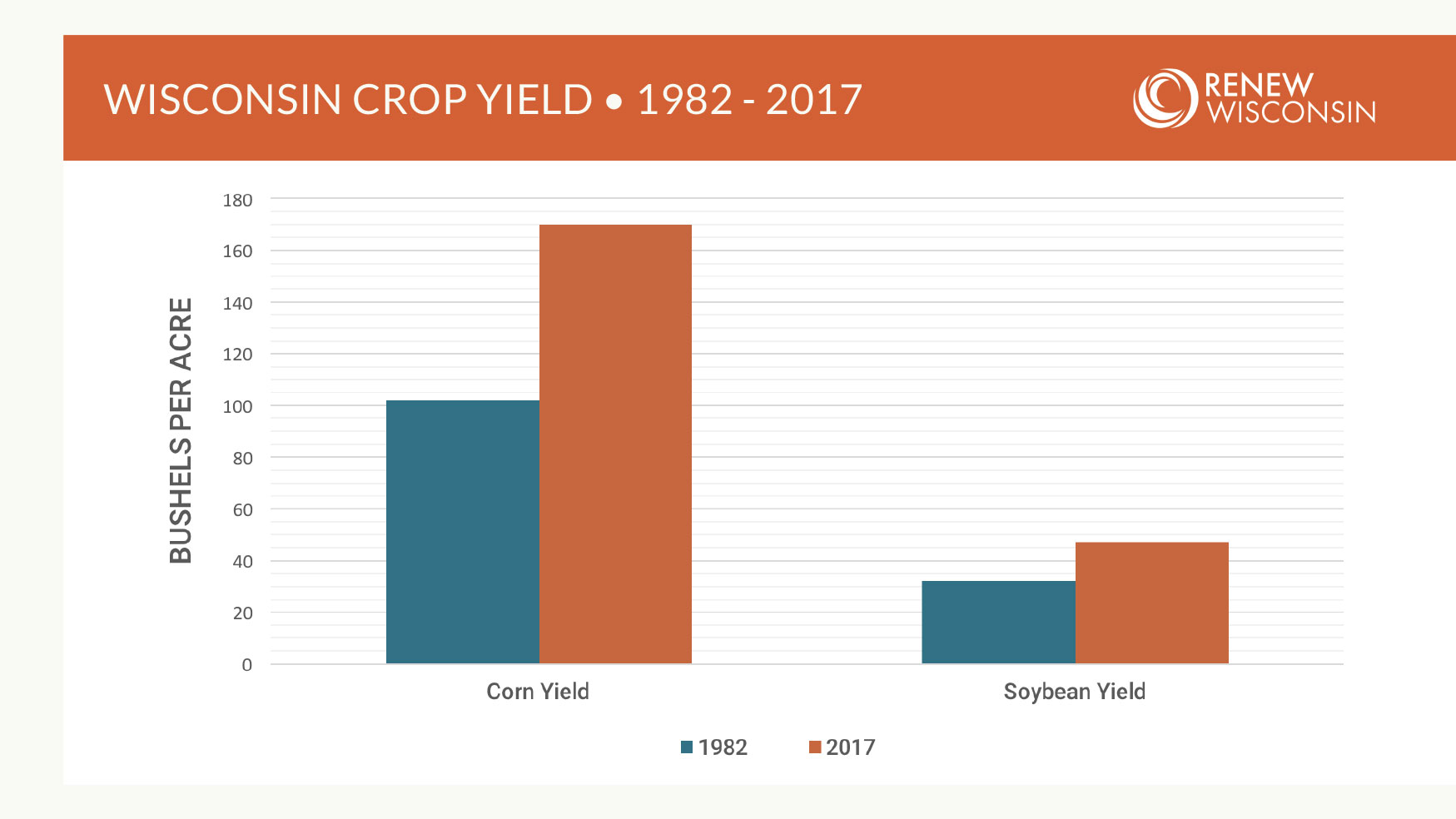
As crop yields are expected to continue increasing and productivity of harvested land is improved, a new set of issues are presented. The depressed commodity prices of corn and soy exist today because yields have gone up considerably, leading to an oversaturated marketplace. The loss of important export markets also acts as a compounding factor upon the current commodity prices of corn and soybeans. These factors have created unfavorable conditions for conventional crop farmers in Wisconsin and throughout the Midwest, and crop producers are looking far and wide for new ways to generate revenue.
Farm Land: Energy Production & Conservation
Our research turned up another unexpected fact: many farmers today are already in the energy production business. About 37% of the corn already grown in Wisconsin is used for ethanol, a common form of biofuel. Another way to look at this is that more than one million acres of farmland are allocated each year, on average, for the production of corn for biofuel.
If just 11% of that land was allocated for solar PV, rather than ethanol production, we would generate enough power to supply 50% of our state’s electricity demand exclusively from solar. Incorporating solar onto the farm is simply another form of Wisconsin-made energy that farmers can provide our state.
Not only would the footprint of land to meet 50% of our electricity needs be small relative to other uses, it is a more efficient use of land as well. One acre of corn produces enough ethanol for an E15 vehicle to travel about 11,000 miles over the course of a year. One acre of solar PV provides enough energy equivalent to power 715,000 miles worth of battery electric vehicle travel.
It is also worth keeping in mind that federal taxpayers are already paying to take cropland out of production through the U.S. Conservation Reserve Program. Today in Wisconsin, nearly 100,000 acres are not being farmed in order to preserve the land, but also to reduce the total amount of crops produced in order to manage oversupply.
Farmland preservation programs require subsidy through tax dollars paid to the federal government. In contrast, utility-scale solar projects provide very similar land preservation and conservation benefits as the Conservation Reserve Program, but do not require taxpayer dollars. In fact, they inject money into the host communities through host lease payments, the county and municipal aid distribution formula and utility aid distribution formula found under Wisconsin’s Shared Revenue Formula, and increased local spending.
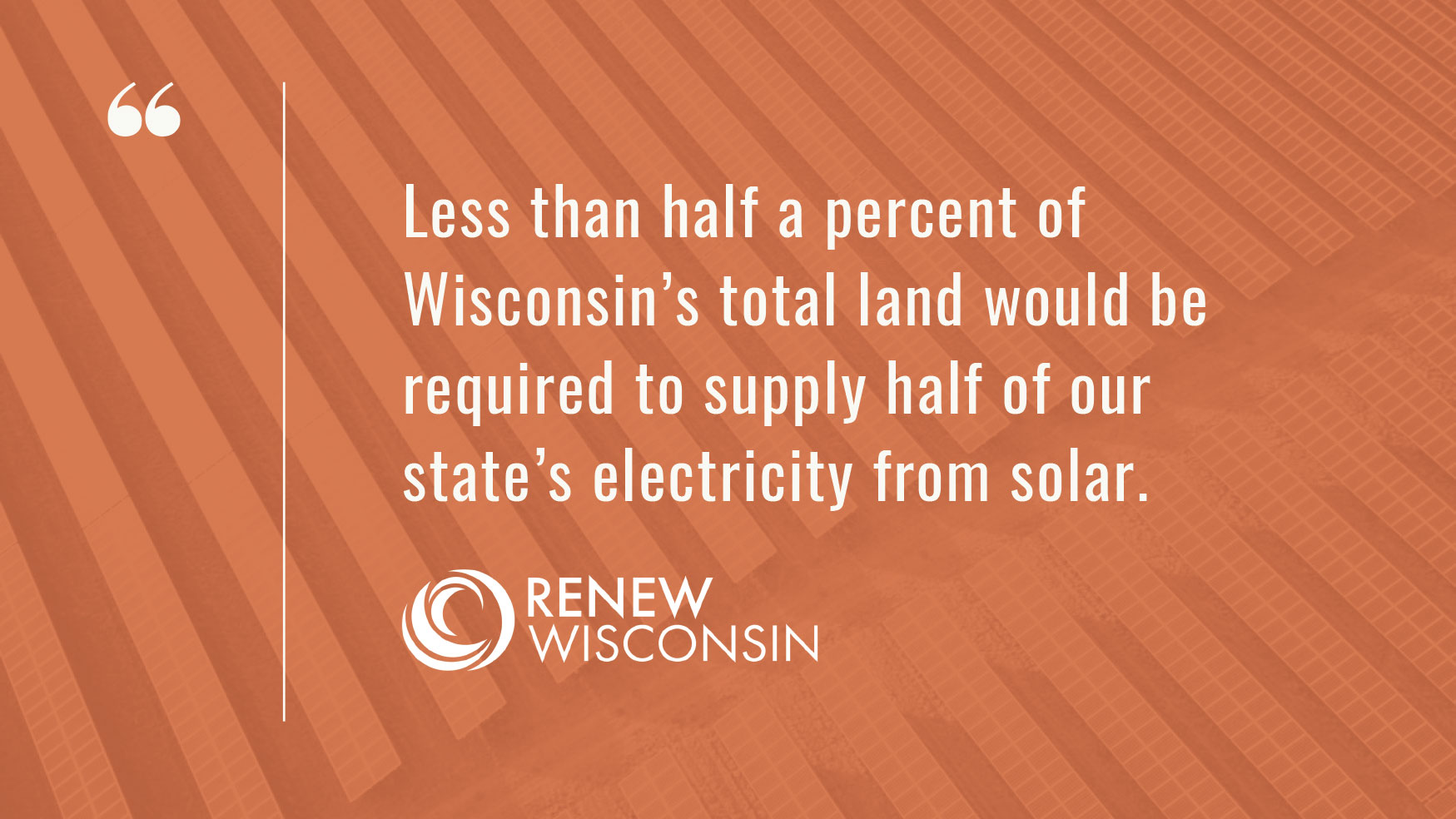
So How Much Land Would Solar Use in Wisconsin?
The current circumstances of conventional crop farming in Wisconsin has created favorable conditions for a new brand of farming; solar farming. In 2017, Wisconsin electricity sales totaled about 69 million megawatt-hours. In order to offset 50% of Wisconsin’s electricity demand, about 120,000 acres of land would be used to produce electricity from utility-scale solar PV. Assuming a land footprint of seven acres per megawatt (based on Invenergy’s Badger Hollow Solar project), Wisconsin would have about 17,100 MW of utility-scale solar deployed across the state generating clean, Wisconsin-made electricity.
The land required to supply half of our state’s electricity from solar PV is approximately the same amount that is currently preserved through the Conservation Reserve Program. Alternatively, less than half a percent of Wisconsin’s total land would be required to supply half of our state’s electricity. In short, the total land footprint of solar relative to other cropping regimes, preservation programs, and land taken out of production is strikingly small.
Figure 3.
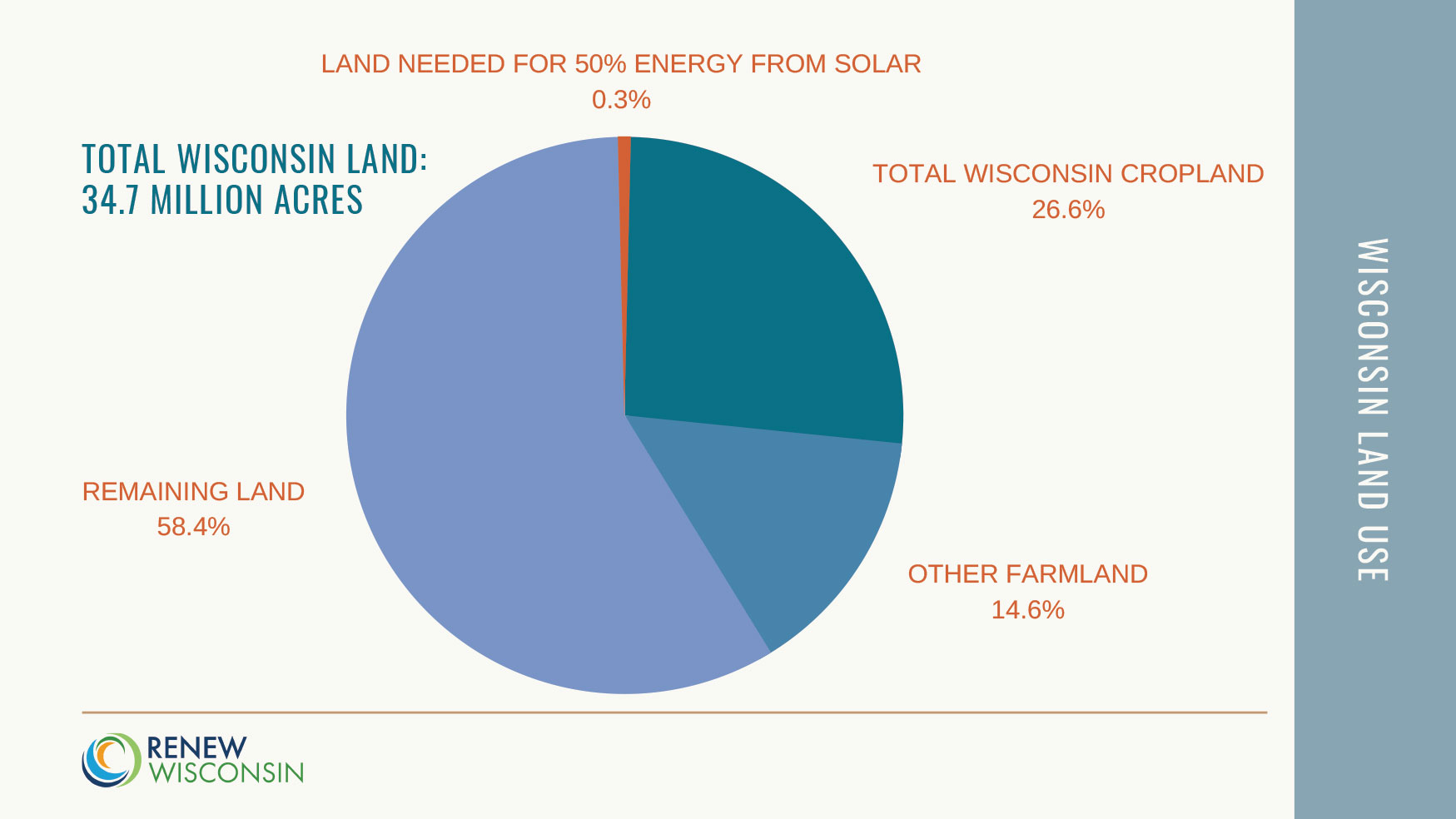
How much land does solar use compared to coal?
The last component of our analysis looked at the physical footprint of imported coal relative to solar PV. As of 2017, Wisconsin imported nearly 22 million short tons of coal, accounting for about 50% of the state’s energy mix. While we don’t see the extraction of this coal from Wyoming coal fields, the amount of coal mined from the earth to power our state is substantial.
If we assume that we’re mining coal six feet deep, then we would have to mine about 135,000 acres of coal over a 40-year period in order to produce 50% of Wisconsin electricity from coal we are using. A solar farm is estimated to last 40 years, so we must compare 40 years of operation and coal mined in order to see the apples-to-apples comparison of land use.
Thus, although the footprint of a coal plant in Wisconsin is smaller than solar farms, those coal plants have a very similar total land impact because of how much coal has to be mined to fuel them!
While the thought experiment of replacing coal storage with solar fields is not one-to-one, this point gives particular attention to the true physical footprint of our energy consumption. It is also important to keep in mind that this analysis does not include additional land used for the transportation of 22 million short tons of coal or land dedicated to coal ash disposal. Each year we send hundreds of millions of dollars out of our state to purchase and import the coal and natural gas needed to power the various coal-fired and natural gas power plants throughout Wisconsin. With Wisconsin-produced electricity from solar we are leaving carbon in the earth, keeping dollars in the state, and creating well-paying jobs.
Figure 4.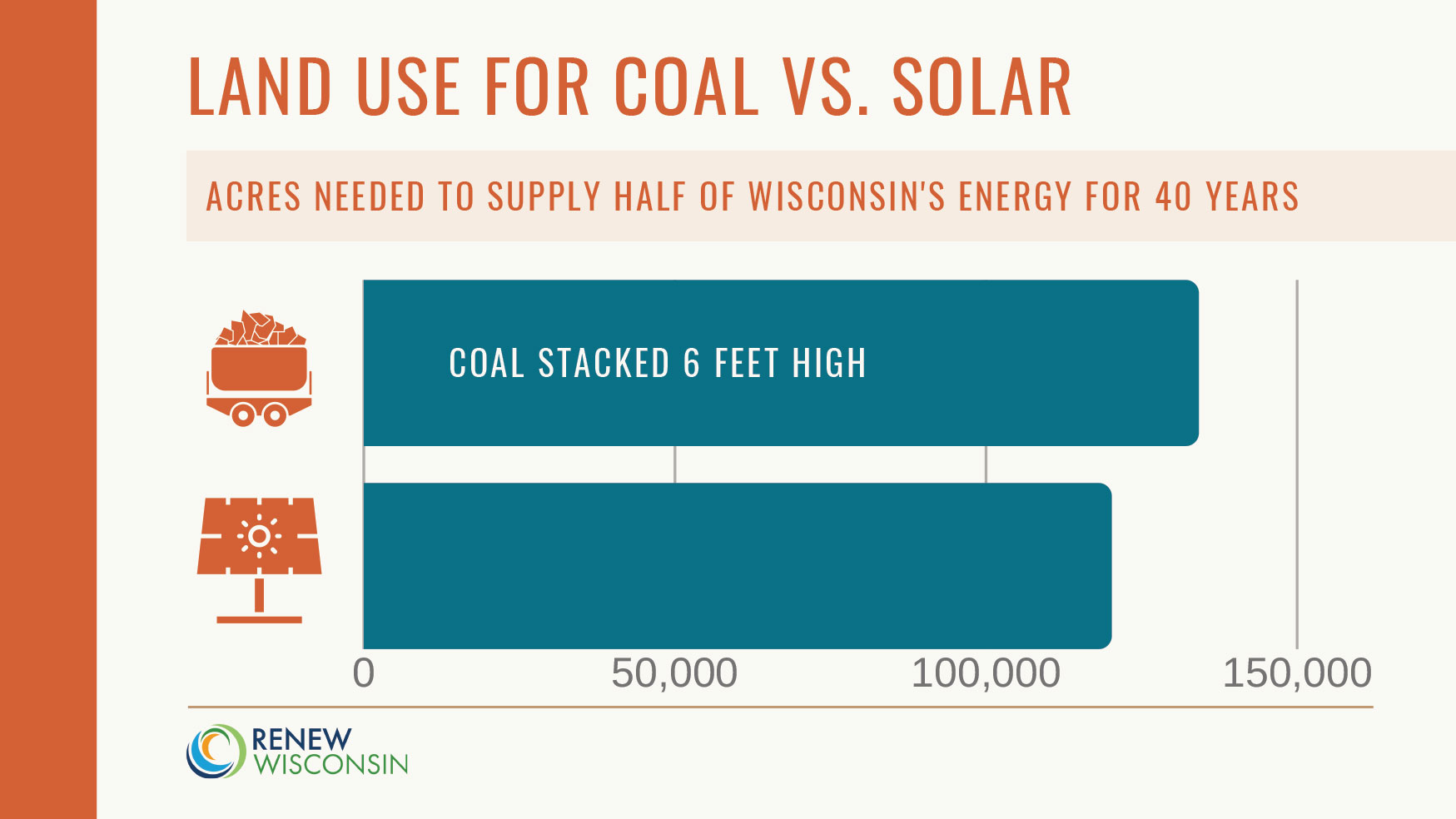
Conclusion: Solar Farms Will Benefit Wisconsin
Wisconsin farmers have played a crucial role in providing food and energy to our communities for decades. Farmers now have a new opportunity to provide clean, renewable energy to the people of Wisconsin today and well into the future. Trends in conventional crop production have fostered ripe conditions for farmers to implement new ways to generate revenue. Crop yields are up, we are growing far more crops on less land, and commodity prices are low due to market conditions largely beyond farmers’ control.
With solar farms, we’ll be far more energy independent, and millions of dollars will be pumped into our rural communities. Solar-hosting farmers will have a new, reliable source of revenue for years to come.

by Jane McCurry | May 16, 2019 | Electric Vehicles
Image courtesy of Union of Concerned Scientists.
One of the most common questions people ask me is, “Are electric cars really better for the environment?” The resounding answer is, “Yes!”
The logic behind the question is sound; if cars run on electricity, and electricity is made with coal, then electric cars are powered by coal. And is coal really better than gasoline?
Well, yes and no. Ideally, our electricity wouldn’t be made from fossil fuels. But, even so, driving electric produces fewer emissions than driving a gasoline car.
No Matter Where you Drive, Electric Cars Produce Fewer Emissions
Union of Concerned Scientists spent years answering this question. Their scientists added up the total emissions from conventional cars and from electric cars. They found that electric cars produce half the emissions of the average gasoline car.
Their findings show that across the country electric vehicles produce the emissions-equivalent of an 80-mpg car. Even in Wisconsin, where the majority of our electricity comes from coal, electric vehicles are far cleaner than the average gasoline car even considering the emissions produced during the manufacturing of the car.
Manufacturing Emissions Paint the Wrong Picture
Producing any kind of vehicle takes an abundance of resources and energy. Since electric cars have large batteries they take even more energy to produce. In fact, the manufacturing emissions could be over 60% higher than a gas-powered car. However, as soon as the cars start to be driven the emissions decrease significantly.
Electric Cars are a Lot More Efficient
Electric cars convert more energy into forward movement than gasoline cars. Over 60% of the energy that goes into an electric car gets converted into miles traveled. A gasoline car only uses 20% of the energy from gasoline for miles traveled. This means it takes way more energy to power a gasoline engine than an electric one. So, even if both cars are using fossil fuels, the electric car will use less total energy and produce fewer emissions per mile driven.
No Local Emissions
Gasoline cars have tailpipes that emit harmful pollution. Electric cars don’t have a tailpipe, and don’t generate emissions while driving.
This has air quality implications. With a lot of cars operating in close proximity, urban areas and the areas around highways tend to have higher concentrations of air pollution. Since electric cars don’t contribute to pollution in cities and on highways, they can do a lot to help improve air quality.
Drive on Sunshine
Plus, electric cars can drive on sunshine. A gasoline car will never be able to be powered with clean, renewable energy. As more renewable energy continues to be added to the grid, electric cars will continue to get even cleaner.
If you don’t want to wait for the grid to get cleaner, consider getting solar panels for your home. Or, if you already have solar power, consider buying an electric car to drive on sunshine! Research shows that people who own solar panels are way more likely to also own an electric car.
So, while an electric car takes more energy to produce, it consumes way less energy during its life. If you care about the emissions of your vehicle, it’s time to ditch the gasmobile.
There are an abundance of other reasons to switch to driving electric, so keep in touch to find out more!












